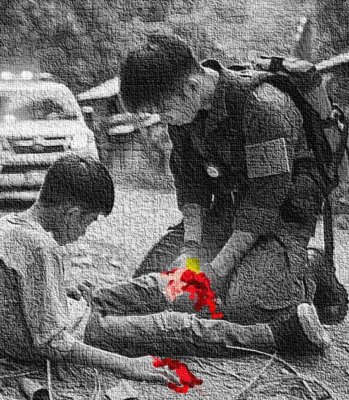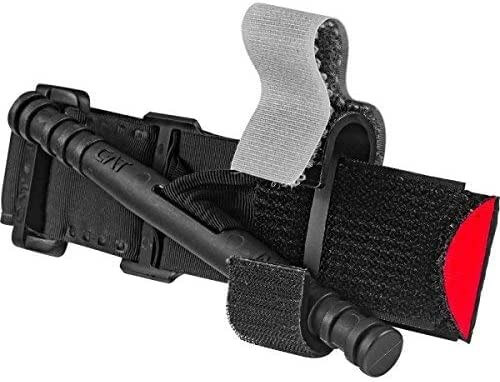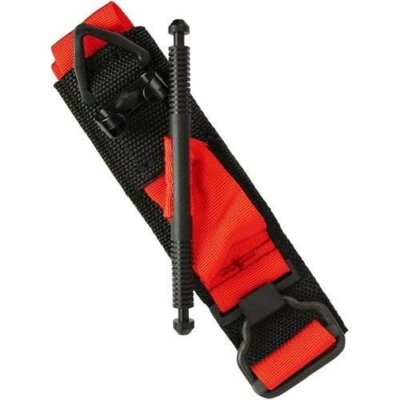
Imagine you are the young man in the image above. Can you stop the bleeding and save that boy?
The sight of blood – dark red, pulsing and dripping out of a wound – can cause some people to faint before they can even begin to help. If you are one of those people, this article probably isn’t for you. For the rest of us, though, it’s time for a reminder about one of the most important trainings available to ordinary citizens: “Stop the Bleed.”
Here’s the shocking reality, per Homeland Security: “The average time for first responders to arrive is 7-10 minutes. The average time for someone to bleed out after experiencing serious physical trauma from an injury . . . is only 3-5 minutes.”
I have known these statistics for a while. And I knew that if I were the person kneeling by the boy in the image, I would not be ready to save him.
So last week, Joe and I signed up for a Stop the Bleed training put on by our local fire and police departments as part of the CERT program.
What I remembered from “tourniquet training” in the old days.
If you’re over 70, you may recall how early first aid classes dealt with severe bleeding. (My older brothers were both Eagle Scouts, so I got the training when they did, sometime in the 50s.) That training was simple. First, try to stop the bleeding by pressing down hard on the wound with a towel. If that didn’t work, tie your belt or even a bandana around the bleeding limb, above the wound, and twist it tight.
Really, that is pretty much all I remember about using a tourniquet. But it came with a vague warning about “not leaving the tourniquet on for too long.”
Concerns about leaving a tourniquet on “for too long” were legitimate, of course. We all understood that limbs denied blood could ultimately be lost. And in those days, when response times for medical help were probably in hours, not the minutes we expect today, this warning was enough to turn us off to this first aid option.
Today we have new data, new tourniquets, and new training.
It was the military experience – and data capture – in the wars in Iraq and Afghanistan that re-established the value of the tourniquet as a life-saver in situations of severe trauma. Today, not only do all soldiers carry tourniquets – and know how to use them – but so do police officers and other emergency responders. (I checked with my local traffic officer, and sure enough, he had one on his belt!) And in 2015, ordinary citizens were invited to participate through the Stop the Bleed program.
IMPORTANT NOTE: You will not become trained in stopping the bleeding simply by reading this Advisory, or, for that matter, by taking an online course. You’ll need hands-on training. But if you keep reading for just 3 more minutes, you can get the basics – and maybe be inspired to get the hands-on training.
Step One – Analyze the situation.
- As noted, in a bleeding emergency, time is of the essence. You, as bystander, are going to be there before First Responders arrive. YOU ARE the first responder in this emergency!
- Before you do anything else, check that you are safe and that nothing else is threatening you or others.
- Faced with a wound that is seriously bleeding – pumping out, pooling on the ground — Call 911 or tell someone else to do it.
Step Two — Decide how to stop the bleeding.
Consider these three actions designed to squeeze the artery that’s emptying the blood out your victim’s body. All three of these take PRESSURE!
- Apply direct pressure on the wound using your hand/s. You can use a big bandage, a shirt, whatever. PRESS HARD on the wound and don’t quit. Tell the victim it will hurt, because it will.
- If the wound is a deep cut or deep hole, a surface bandage or pressure won’t work. PACK THE WOUND with gauze, a towel, a t-shirt, whatever . . . until the wound is fully and tightly packed and has stopped bleeding. Again, this will hurt the victim – it’s the cost of staying alive!
- If neither of these efforts works, and the blood is still pumping from an extremity (arm or leg), APPLY A TOURNIQUET. This is where practice is essential. Your face-to-face course, the online course, or YouTube videos will demonstrate where to apply a tourniquet (loop the strap above the wound on the arm or leg), how to tighten it (using the buckle and then the windlass), and to fasten it securely. Once again, the purpose of the tourniquet is to stop blood from flowing out of a wound in an arm or leg. Once it’s on, don’t loosen it or take it off – that’s the job of an emergency medical professional.
You won’t be able to apply a tourniquet unless you have one. So let’s look at adding a tourniquet to your first aid kit.
We tested two different types of tourniquets in our class, and I have since then done a fair amount of research to see what’s available online. Here’s some of what I found.
- First thing you’ll notice is that tourniquets seem to come in two types: American-made at around $30 each, and foreign-made costing as little as $6 each. Cheap tourniquets look very similar to “real” ones – but they can actually not fit right, wrinkle, or even break. My recommendation: budget $30 – $40. If you need a tourniquet, you want it to work!
- American tourniquets come in two colors, black and orange. Color doesn’t seem to make a difference in quality. I like orange because it’s a lot more visible in a dark pack.
- The two most popular tourniquets do have slight differences in how the strap goes around the arm or leg and fits into the buckle, and how the windlass (the bar that you turn to create the pressure) is fastened. Both have a place to write the TIME the tourniquet was placed.
Some examples to look for:

The CAT, or Combat Application Tourniquet, is a true one-handed application (meaning you could put it on your own arm or leg) to stop the bleeding from a serious wound. To get to Amazon’s sales page, with more details for this classic tourniquet, click here. As you know, if you purchase through this link, we may get a small commission – which helps me do all the research for these Advisories!
Here’s a second, American-made tourniquet, the SOFTT-Wide, Gen 4. This tourniquet comes in several models; I like the bright color and, in particular, the extra fastener that keeps the windlass secure once the tourniquet is applied. (Hands slippery with blood, etc . . .) Again, head to Amazon for details and prices.

At our class we practiced with both models. It took me about 4 minutes to get the tourniquet on the dummy arm and properly tightened. Too long, of course. But that was my very first try. I am confident that now I’ve done it once, I could do it again, twice as fast.
In closing . . .
A tourniquet isn’t for every first aid kit. You will have to be determined and confident to use one in the midst of a frightening, perhaps shocking, emergency involving massive bleeding. But if you are prepared, you may be able to stop the bleeding and save a life that will otherwise surely be lost.
Virginia
Your Emergency Plan Guide team
P.S. If you are investing in a tourniquet, consider adding gauze strips to your purchase. Better than a t-shirt for packing . . .
Don't miss a single Advisory.
Thank you for subscribing.
Something went wrong.

Don’t forget cotton tampons as bleed stoppers. Cheap, and they work quickly.